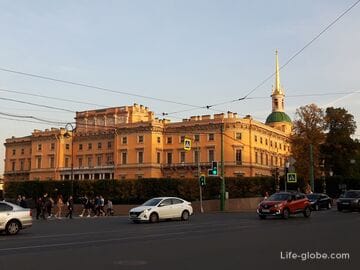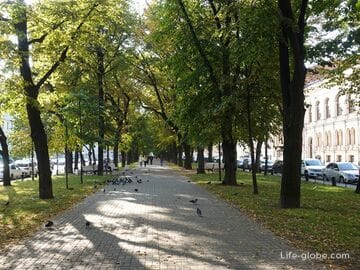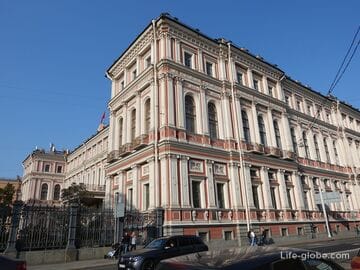The Palace Embankment is one of the embankments in the center of St. Petersburg.
Dvortsovaya is one of the most famous and beautiful embankments of St. Petersburg.
The formation of the Palace Embankment dates back to the 18th century.
During the history of the embankment had several names: "Postal", due to the fact that it was located on the Postal yard; "Cash line", "Upper Embankment Street" and "Millionnaya". After the royal residence was built by the architects of Rastrelli - Winter Palace, from 1778 the embankment was officially called "Palace". Under the Soviet regime, in 1923, the embankment was renamed the "embankment of the Ninth of January". In 1944, the embankment was returned to its former name - "Palace".
The Palace Embankment is located on the left bank of the Neva River and stretches from the Kutuzov Embankment (Fontanka River) to the Admiralteiskaya Embankment (Palace Bridge).
The length of the Palace Embankment is just over one and a half kilometers.
The center of the embankment is a roadway with pedestrian sidewalks on both sides. On the north side, the embankment is open to the Neva River, and on the south - almost unbroken rows of historical buildings are lined up with passes for channels that flow into the Neva.
The buildings along the embankment are an architectural ensemble.
Among the buildings along the Palace Embankment, such dominants as: the facade of the Winter Palace, Hermitage Theater, Novo-Mikhailovsky and Marble palaces.
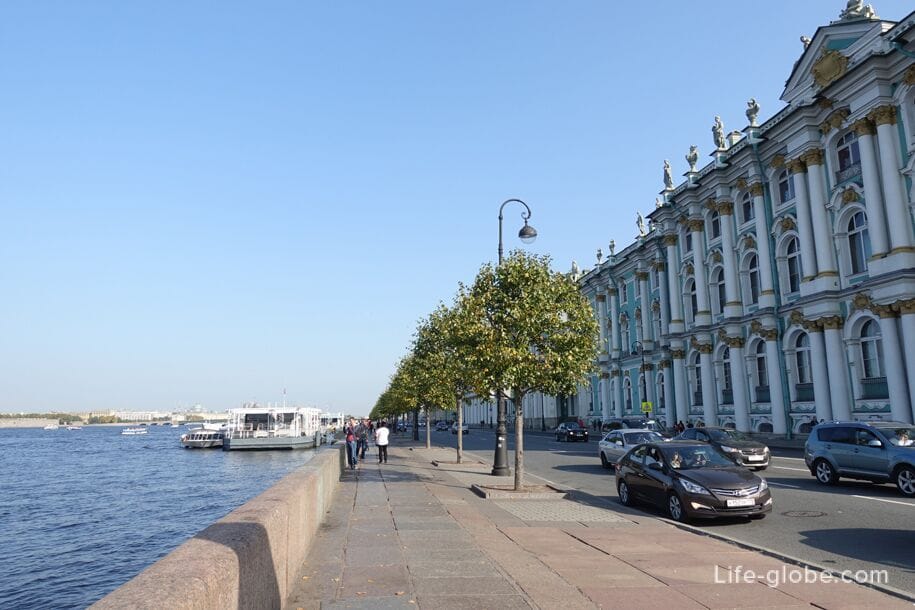
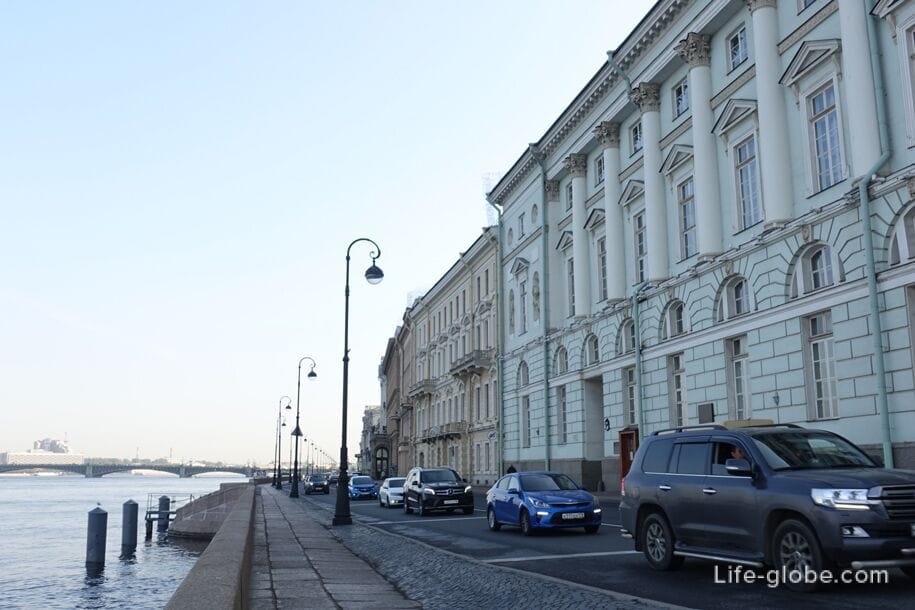
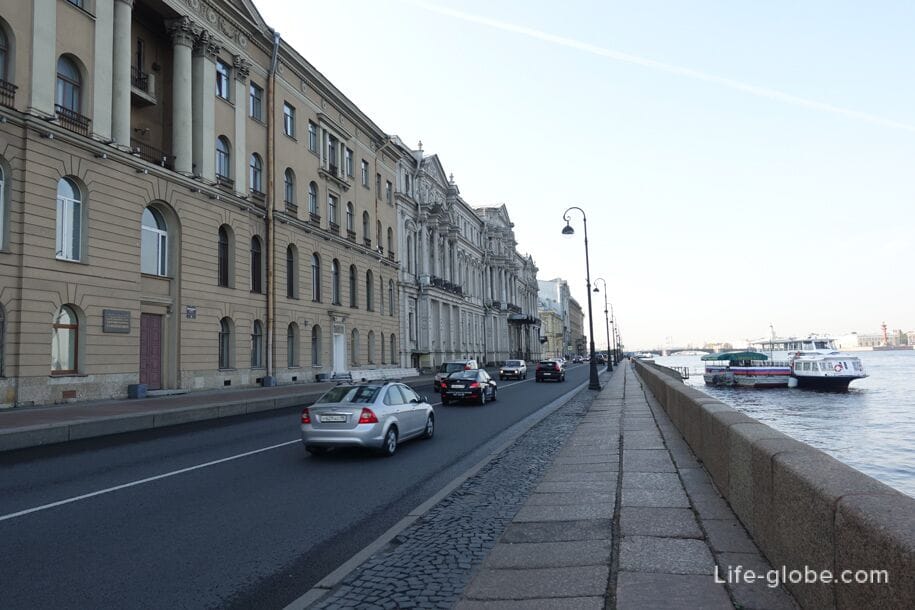
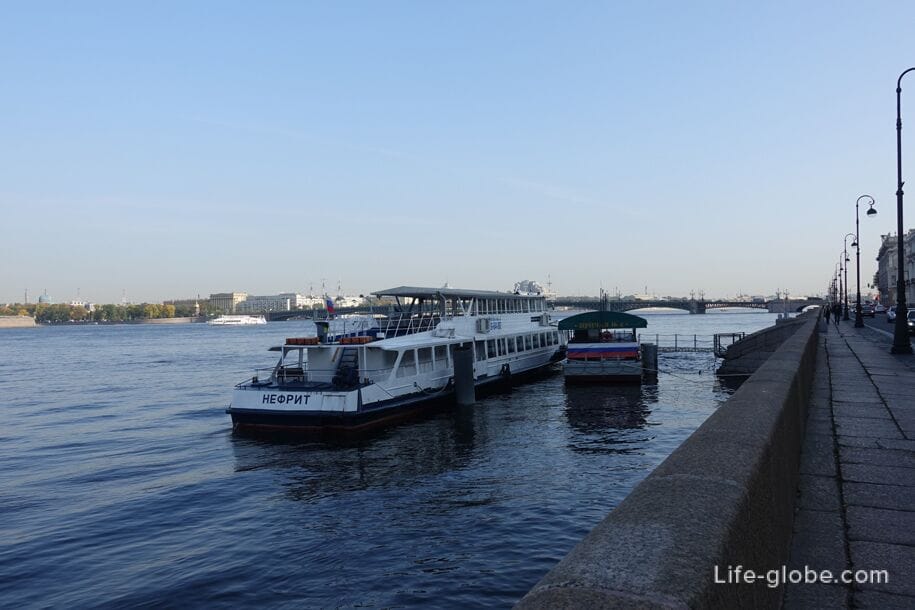
Views of the Palace Embankment
The best panoramic views of the Palace Embankment and the accompanying architectural ensemble are opened from the "Nevsky Panorama", which is a walking route that runs along one of the walls of the Peter and Paul Fortress: between the Gosudarev and Naryshkin bastions. Entrance to the Nevsky Panorama is paid.
You can also enjoy a panoramic view of the embankment from the observation deck located in the bell tower Peter and Paul Cathedral. Entrance is paid.
You can enjoy the Palace Embankment for free from the beach near the Peter and Paul Fortress, from the pier Nevsky Gate of the fortress or Botardo Ioannovsky ravelin.

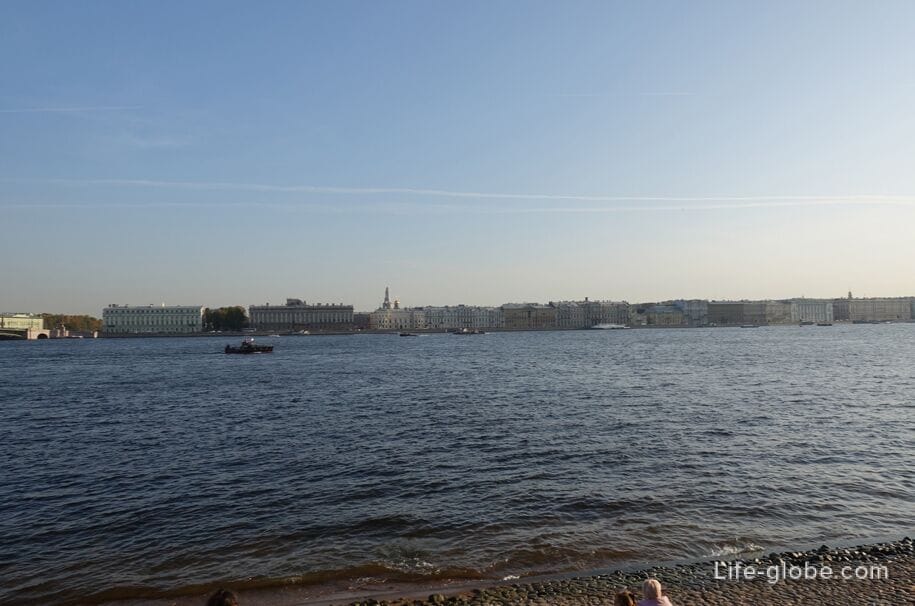
You can see the embankment from a different angle from the Trinity or Palace Bridges.
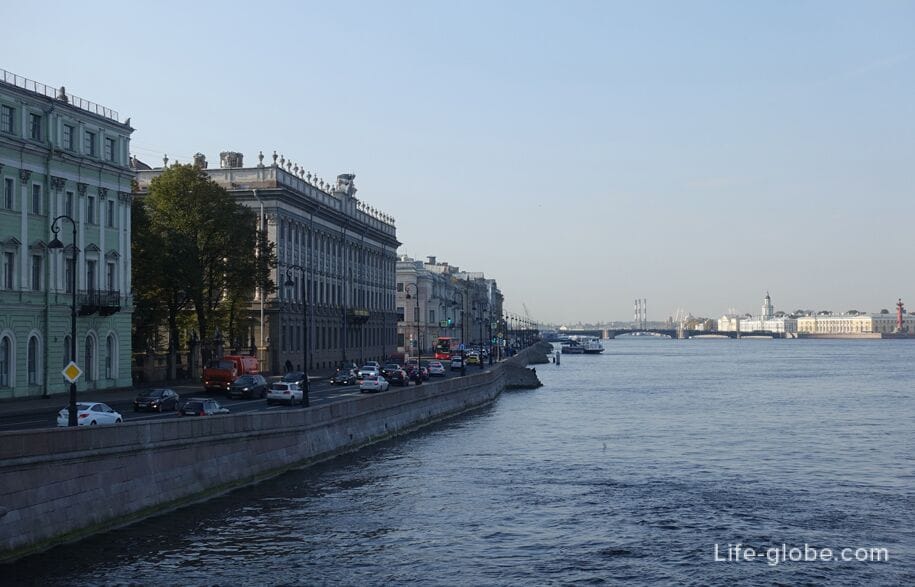
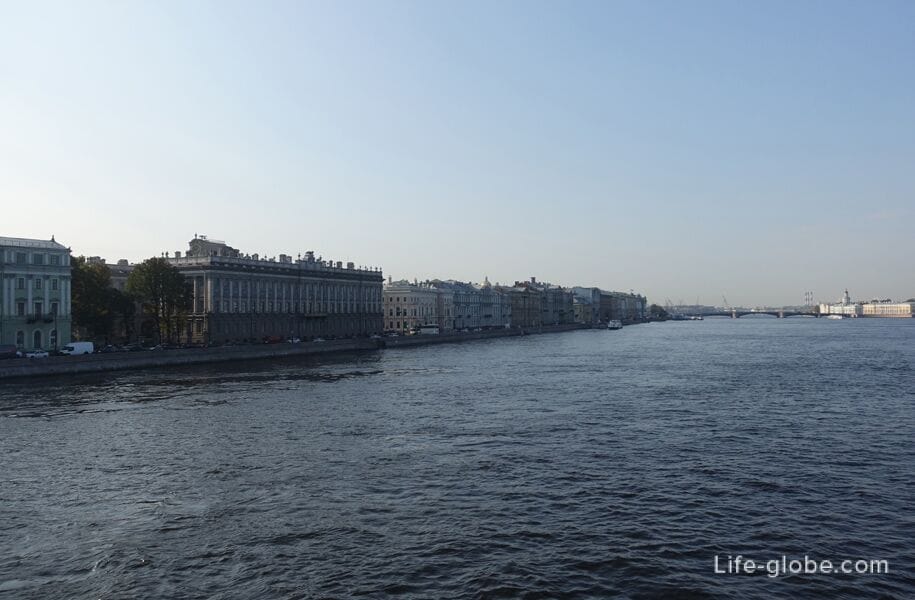
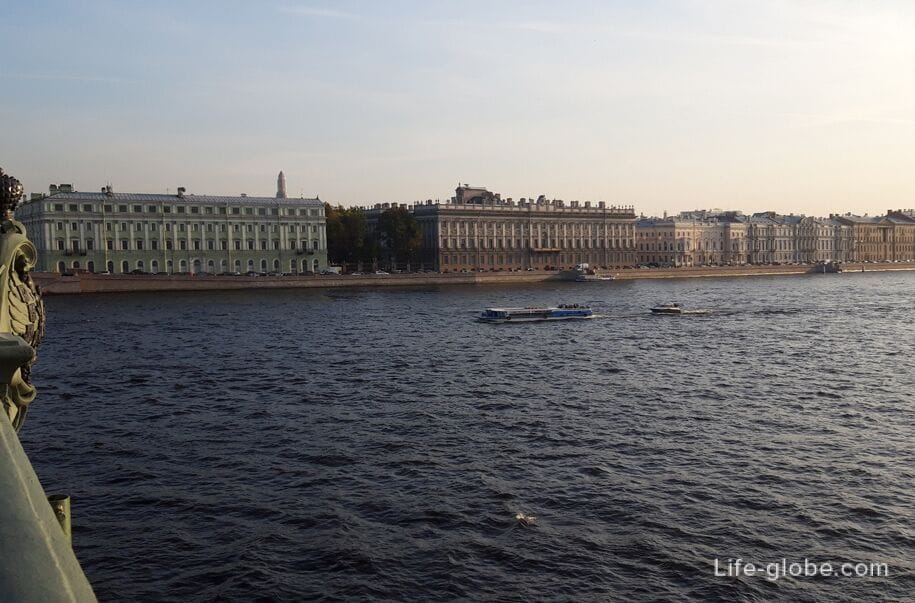
You can also view the Palace Embankment from the waters of the Neva River, taking a walk along the rivers and canals of St. Petersburg by boat.
Views from the Palace Embankment
From the Palace Embankment, you can enjoy beautiful views of the Peter and Paul Fortress (Hare Island) with its dominant features - the high spire of the Peter and Paul Cathedral Tower and the dome The Grand Ducal tomb.
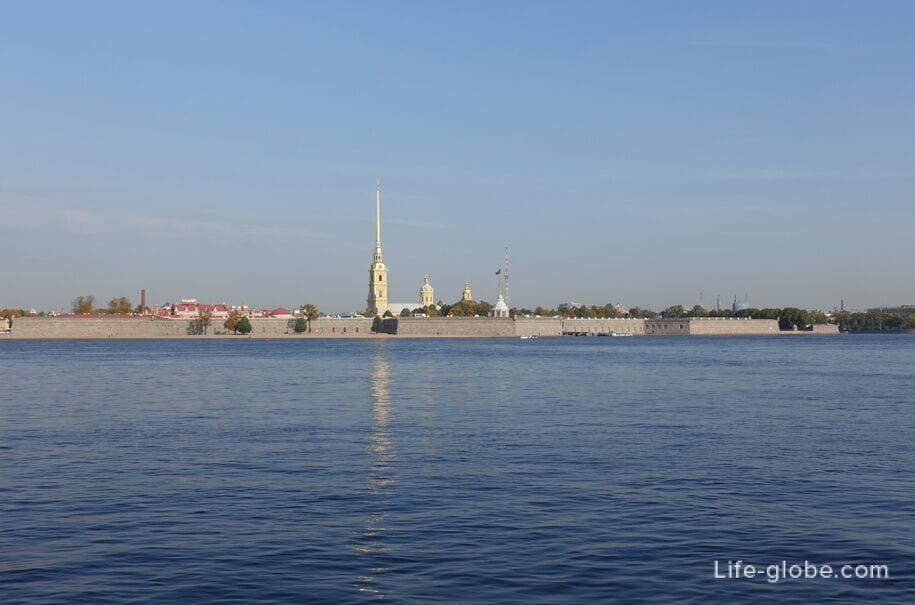
From the embankment, you can also see the Trinity and Palace Bridges, and the architectural ensemble of Strelka Vasilyevsky Island.
View of the Palace Bridge and the spit of Vasilievsky Island
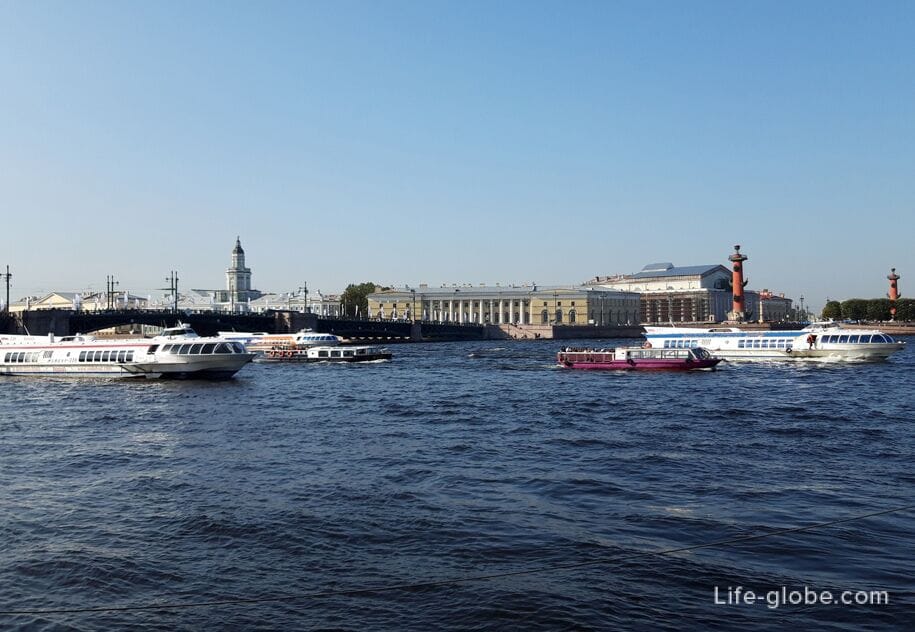
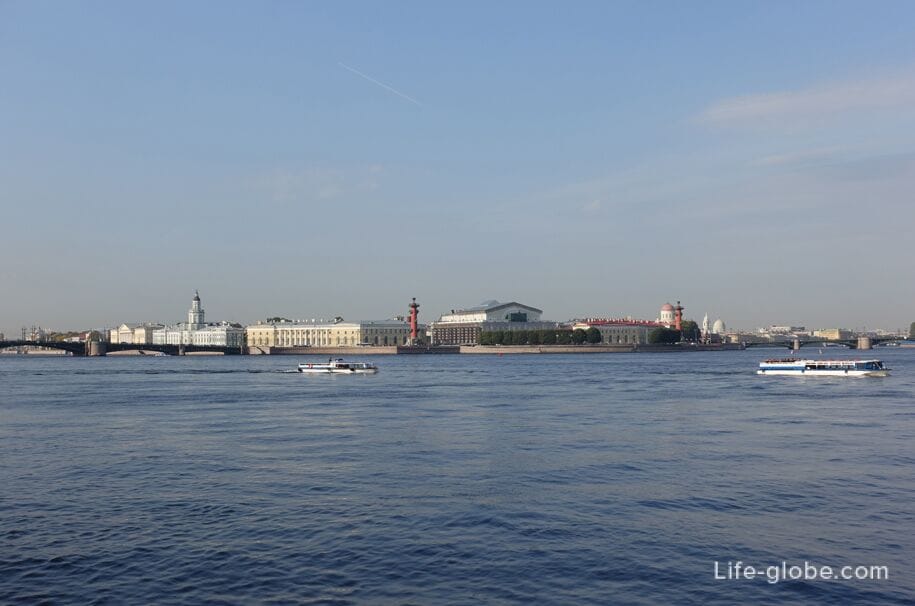
View of the Trinity Bridge
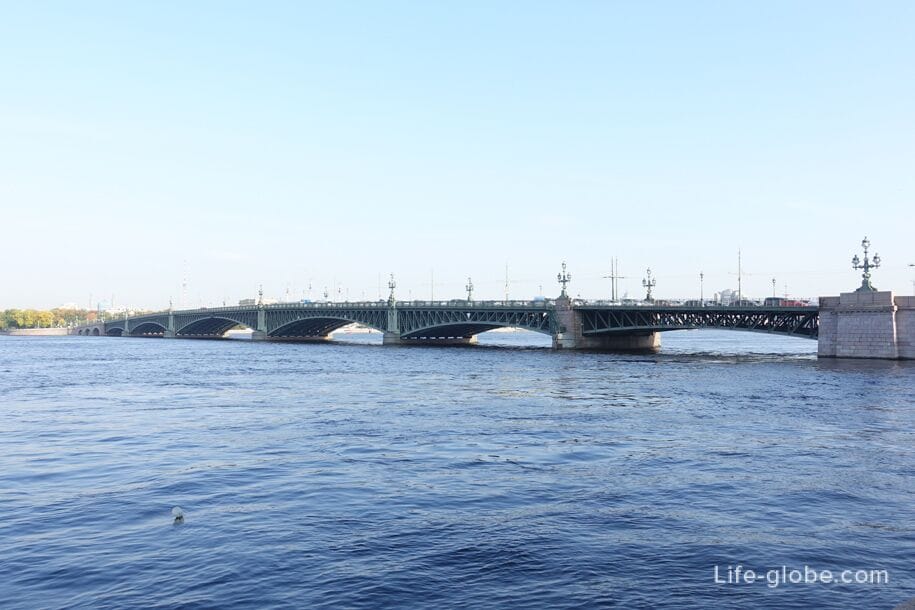
Attractions of the Palace Embankment
The Palace Embankment originates from the Fontanka River, near the Summer Garden, and ends at the Palace Bridge, where it flows smoothly into the Admiralty Embankment.
Laundry Bridge
Where the Kutuzov Embankment meets the Palace Embankment, a small three-span Laundry Bridge spans the Fontanka River.
The construction of the bridge was carried out from 1766 to 1769 under the direction of the architect I. L. Rossi and T. I. Nasonov.
It was one of the first stone bridges in St. Petersburg.
The name of the bridge is "Laundry", due to the fact that there were palace laundries nearby. More about the Laundry Bridge...
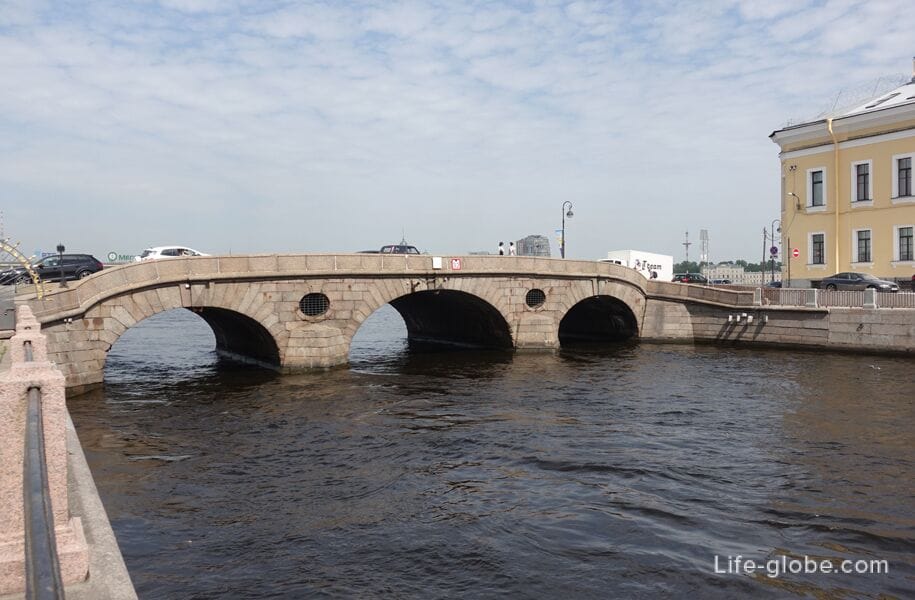
Summer garden
Just behind the Laundry Bridge is the Summer Garden, which is a park ensemble and is a monument of landscape art of the first third of the 18th century.
Along the Palace Embankment there is a lattice of the Summer Garden, which is a landmark and one of the symbols of the city.

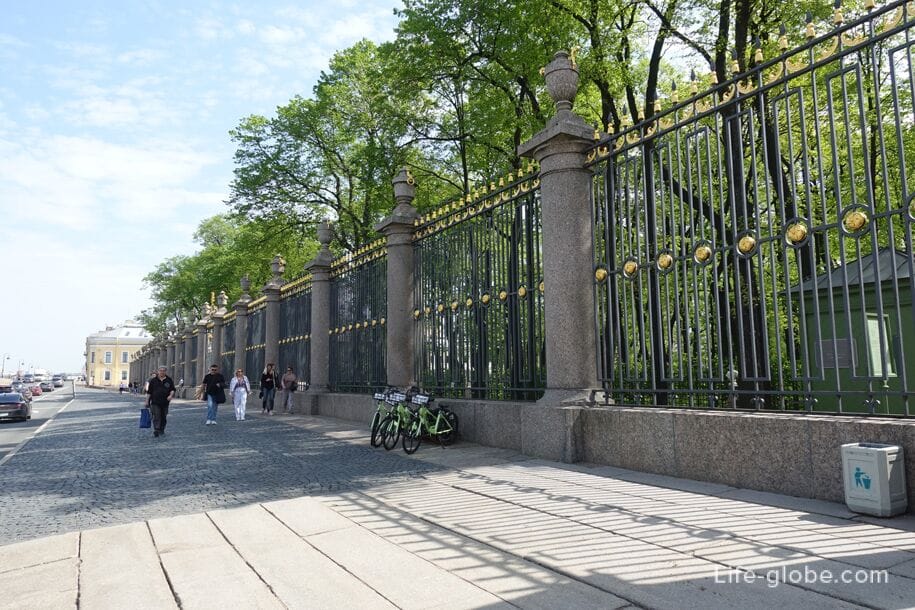
In the Summer Garden there are: pavilions, alleys and paths for walking, cafes, places for recreation, a pond, a parterre, bosquets, borsos, fountains, sculptures, monuments and an exposition of the history of the Summer Garden..
A special place in the garden is occupied by The Summer Palace of Peter the Great is the residence of Peter the Great in St. Petersburg, which has been preserved to this day almost in its original form.
The palace was built in 1711-1712 in the Peter's Baroque style by the architect Domenico Trezzini. Today, the palace is a museum, part of the The Russian Museum. Learn more about the Summer Garden…
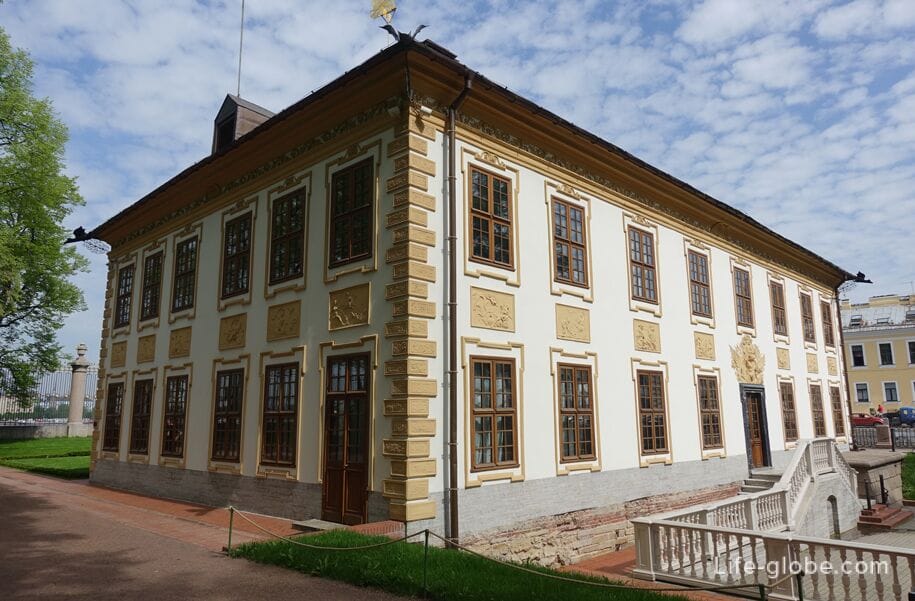
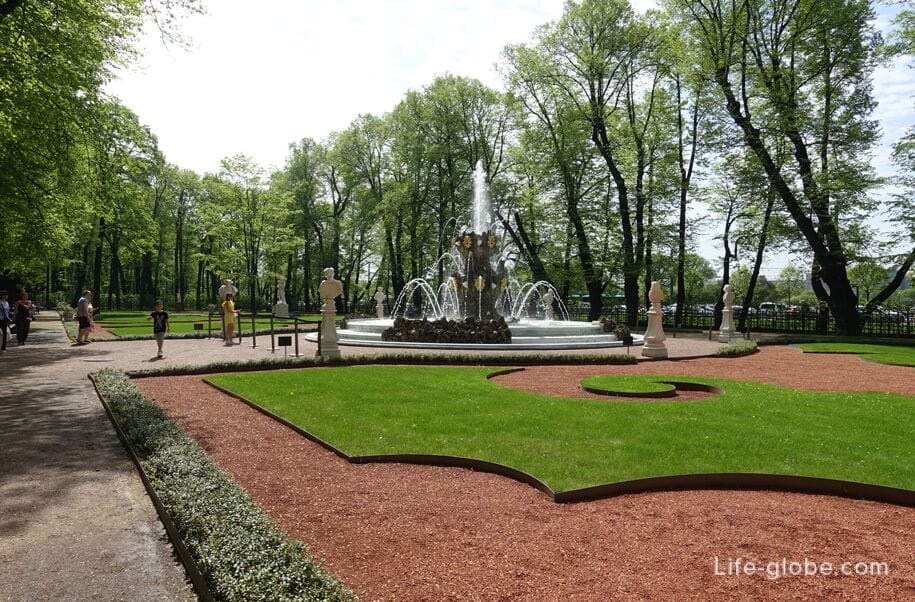
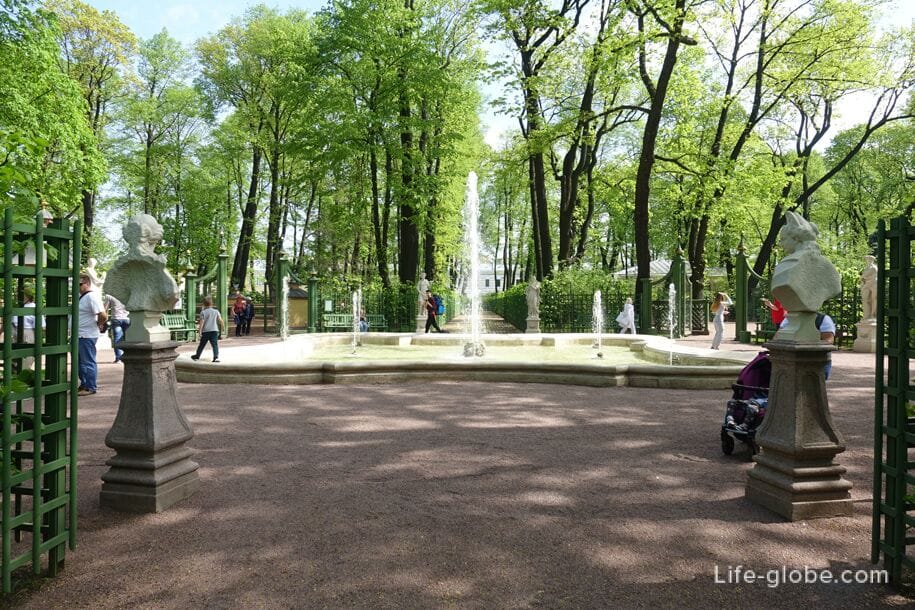
Upper Swan Bridge
The Upper Swan Bridge is a single-span arch bridge over the Swan Channel connecting the Summer Garden and the 1st Admiralty Island.
The first wooden drawbridge on this site was built in 1711-1715, immediately after the canal was dug. In 1754, the bridge was rebuilt in wood.
In 1767-1768, during the construction of the granite embankments of the Neva River, the bridge was rebuilt into a single-span arched stone bridge.
The exterior design of the bridge has been preserved to this day in its original form. Learn more about the Swan Groove and bridges...
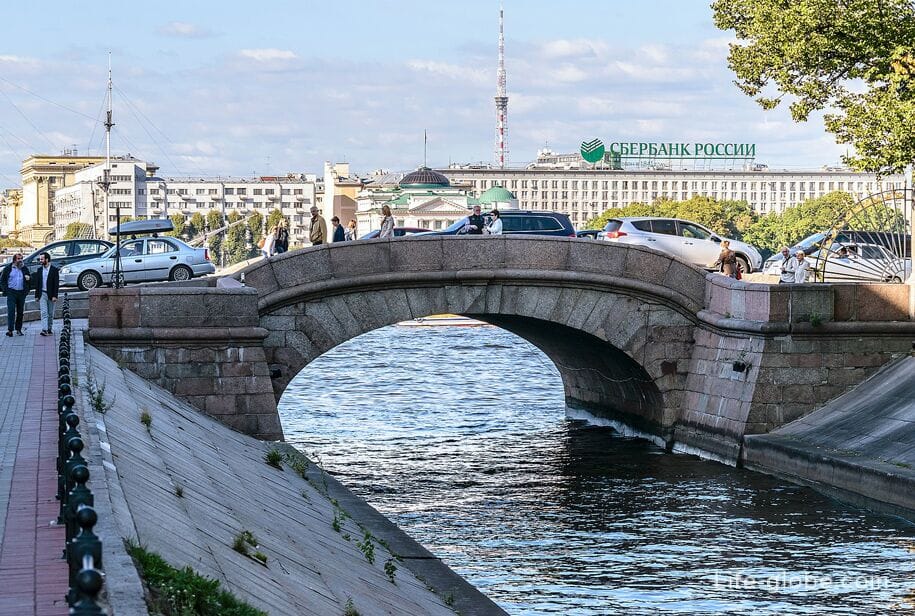
Betsky House
At the address: Dvortsovaya Embankment 2, there is a historical building-the house of Betsky or the palace of the Prince of Oldenburg.
The building was built in the late 18th century as a mansion for Ivan Ivanovich Betsky. Construction was carried out by order of Catherine II on the site of the former Opera House.
In the 19th century, the building had a superstructure.
Today, the building belongs to the St. Petersburg State Institute of Culture and is connected by internal passages to the neighboring Saltykov house.
The southern facade of the house faces the Champ de Mars.
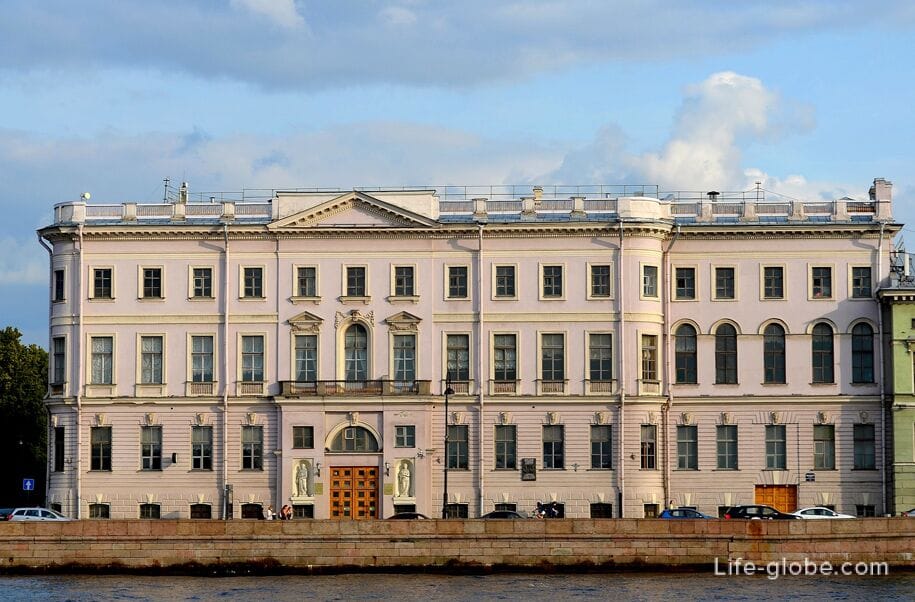
Saltykov House
At the address: Dvortsovaya Embankment 4, there is the Saltykov House, also known as the Groten House.
The building was built according to the project of Giacomo Quarenghi as a mansion for the merchant F. I. Groten.
Subsequently, the building changed its owners, until, on February 3, 1796, the mansion was bought into the treasury and presented to the Russian statesman-Field Marshal Nikolai Ivanovich Saltykov.
Currently, some of the interiors of the mansion are preserved: the lobby, the main staircase and the White Hall.
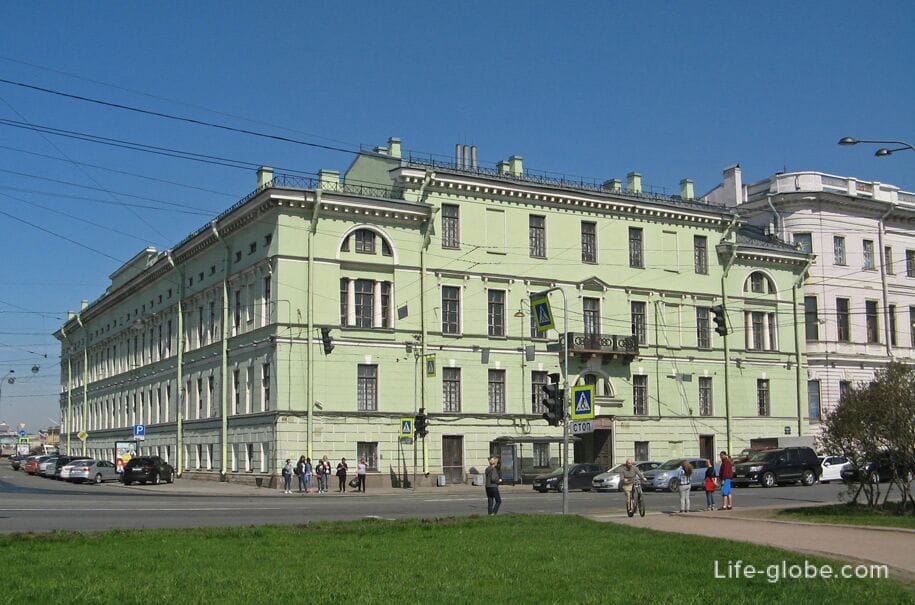
Suvorovskaya Square and Troitsky Bridge
Behind the Saltykov house, an open space - Suvorovskaya Square-adjoins the Palace Embankment on the south side, and the Trinity Bridge spans the Neva River on the north side.
Suvorovskaya Square is one of the largest squares in the historical center of St. Petersburg.
The center of the square is decorated with a bronze monument to the Russian commander Alexander Suvorov, mounted on a high pedestal. Sculptor M. I. Kozlovsky, 1799-1801.


Transport and pedestrian transportTroitsky Bridge is one of the oldest, most beautiful and longest bridges in St. Petersburg.
The popularity of the bridge is also given by the fact that the Trinity Bridge is a drawbridge. Learn more about bridge construction in St. Petersburg…
The bridge connects the central part of St. Petersburg-1st Admiralteiskiy Island (Dvortsovaya Embankment) with Petrogradsky Island (Petrovskaya Embankment).
The total length of the Trinity Bridge is 582 meters, and its width is 23.5 meters.
The bridge consists of 10 spans, which are a combination of cantilever-arch and cantilever-beam trusses.
The bridge is decorated with granite obelisks, which, in turn, are decorated with double-headed eagles and bronze rosters - the bow figures of ships. Learn more about the Trinity Bridge…
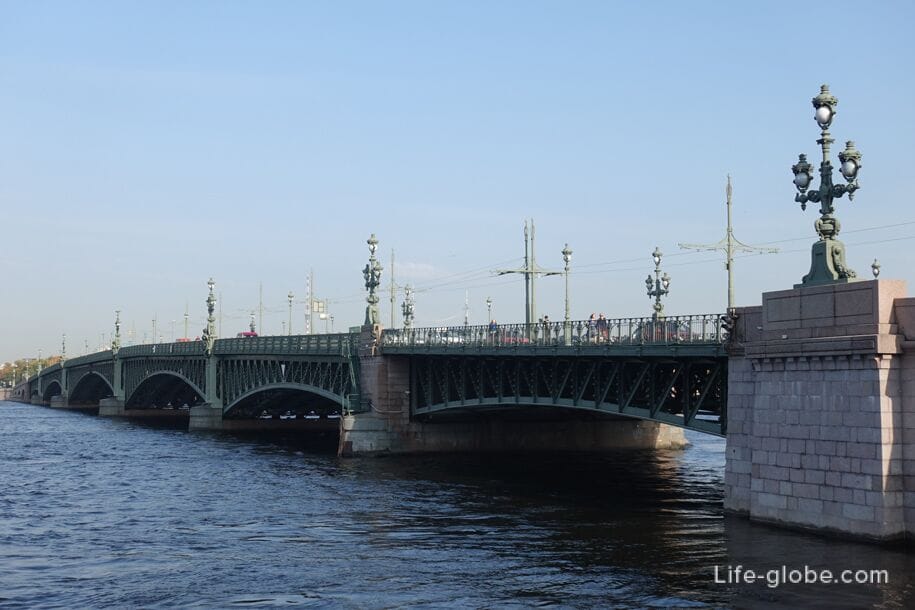
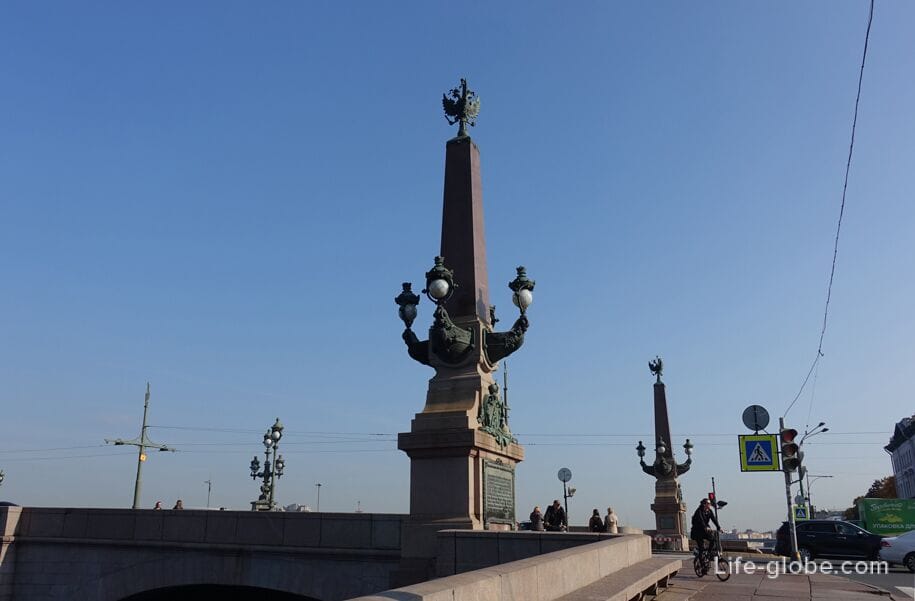
Marble Palace Complex
Further, the Palace Embankment is decorated with the complex of the Marble Palace, consisting of the palace building and the neighboring Service House.
Both buildings are connected by a wrought-iron fence with gilded decorative elements.
The Marble Palace is a monument of Russian architecture of the late 18th century and the first building to be decorated with natural stone.
The palace was built in 1768-1785 by the Italian architect Antonio Rinaldi, by order of the Empress Catherine II.
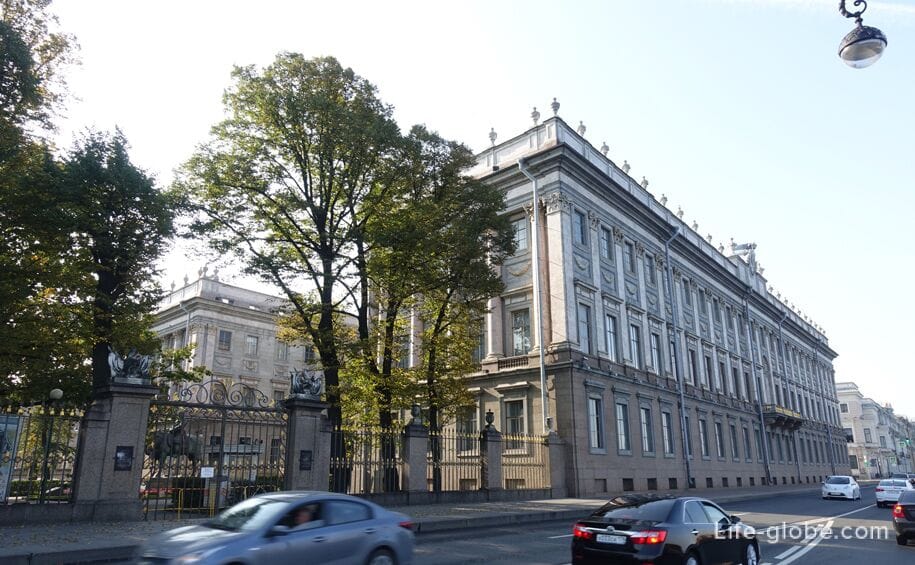
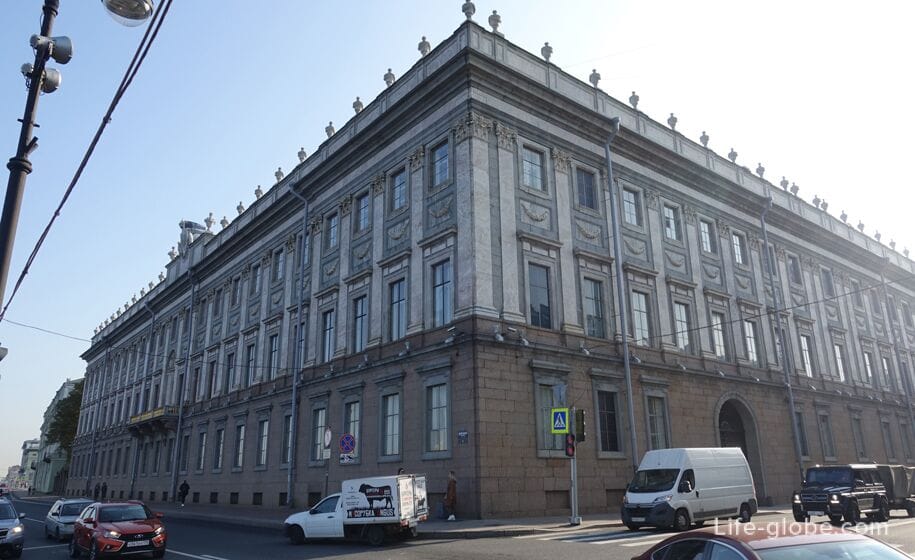
The service house (service building) was built by the architect P. E. Yegorov in 1780-1787 and is a separate building standing to the east of the palace.
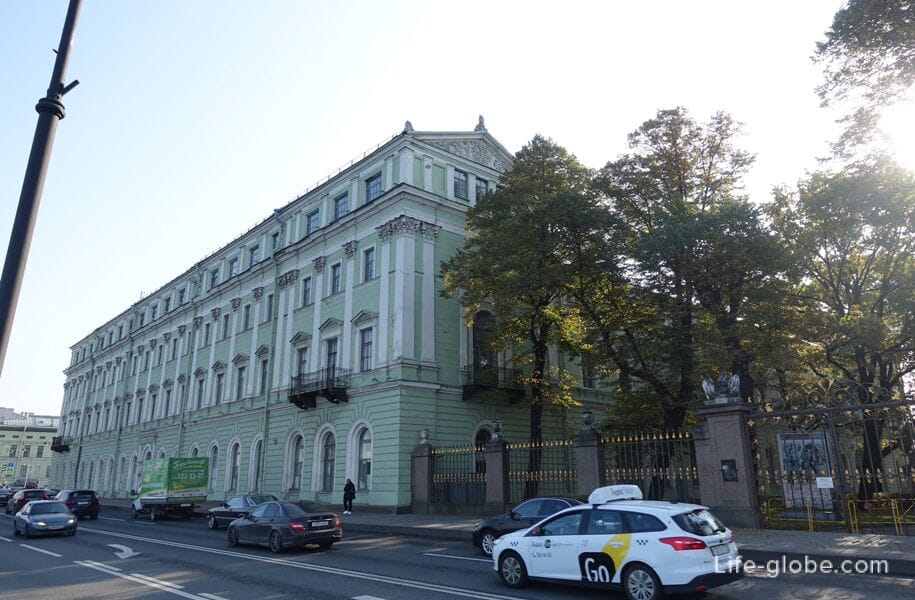
Today, the marble palace belongs to the Russian Museum - within its walls, the museum's collections are displayed and the palace premises are restored: the Grand Staircase, the Winter Garden, the halls, the Greek gallery and the interiors of the personal apartments of Grand Duke Konstantin Konstantinovich, who once owned and lived in the palace.
One facade of the Marble Palace and the Service House faces the Palace Embankment, the second-on Millionnaya Street.
The address of the Marble Palace: 5/1 Millionnaya Street. Learn more about the Marble Palace…
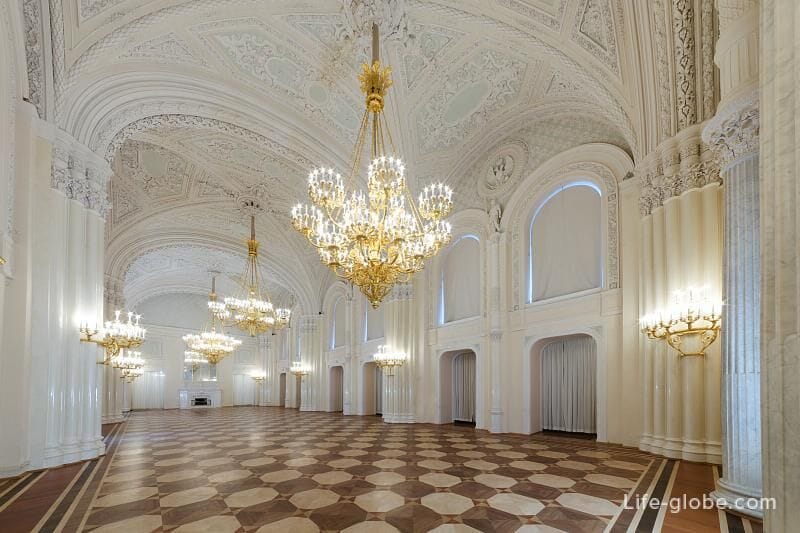
Gromov's Mansion
The Gromov or Ratkov-Rozhnov Mansion is a historic building located on the corner between the Palace Embankment (house 8), Marble Lane and Millionnaya Street.
The building was built in 1720-1725 by the architect Bartolomeo Francesco Rastrelli, commissioned by the Moldavian ruler Dmitry Cantemir, who came to St. Petersburg.
In 1762, Catherine II bought the palace from the Kantemirs and gave it to Count Alexey Petrovich Bestuzhev-Ryumin, who returned from exile.
Subsequently, the mansion changed hands and underwent some changes.
In 1875, the house was bought by the timber merchant and philanthropist Ilya Fedulovich Gromov. By his order, in 1879, the complex of three separate residential buildings was rebuilt into one large mansion with a change in the decor of the facades.
After the death of Gromov in 1882, the owner of the mansion was the former manager of the Gromov family - Vladimir Alexandrovich Ratkov-Rozhnov. He rented out part of the house on the side of the Palace Embankment, and then sold it to the Ministry of Finance.
Today, the Russian Maritime Register of Shipping is located in the building facing the Palace Embankment, and the Institute of Culture is located in the building facing Marble Lane and Millionnaya Street.
The facades of the former mansion are covered with stucco, repeating the motifs of early classicism with Baroque elements. On the side of the Palace Embankment there is a high porch and two heavy bay windows supported by caryatids (statues of dressed women) of the "Egyptian style".
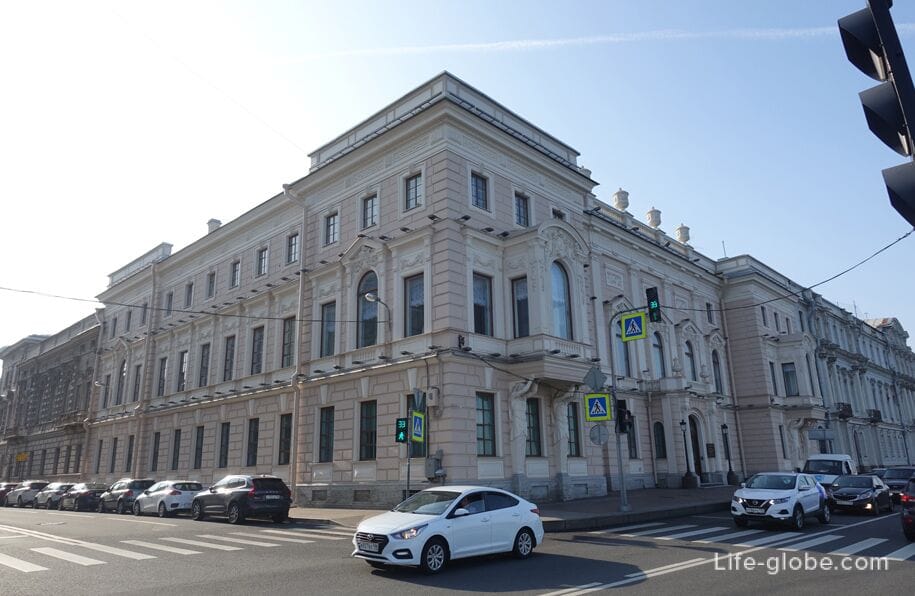

At the corner of Millionnaya Street and Marble Lane, the facade of the building is decorated with a group of three female figures, symbolizing fertility, art and navigation.

Zherebtsova Apartment house
At the address: Dvortsovaya Embankment 10, there is an impressive apartment building of Zherebtsova, also known as the Gagarina mansion.
The apartment building (a residential structure adapted for renting apartments) was built in the late 18th century by the architect Giacomo Quarenghi on the site of a former mansion.
The building was completely rebuilt and expanded in 1860-1863 by the architect L. F. Fontana. The owner of the apartment house was Natalia Pavlovna Zherebtsova-nee Princess Gagarina-the daughter of Prince Pavel Gavrilovich Gagarin.
The facade of the building, facing the Palace Embankment, attracts attention in the Baroque style. Part of the facade of the first floor is decorated with rectangular columns, the second-round Corinthian columns, and the third-caryatids. The balconies of the building are decorated with openwork grating. In the central part, the building is crowned by an attic.
The southern facade of the building, facing Millionnaya Street, is more simple in design and eclectic.
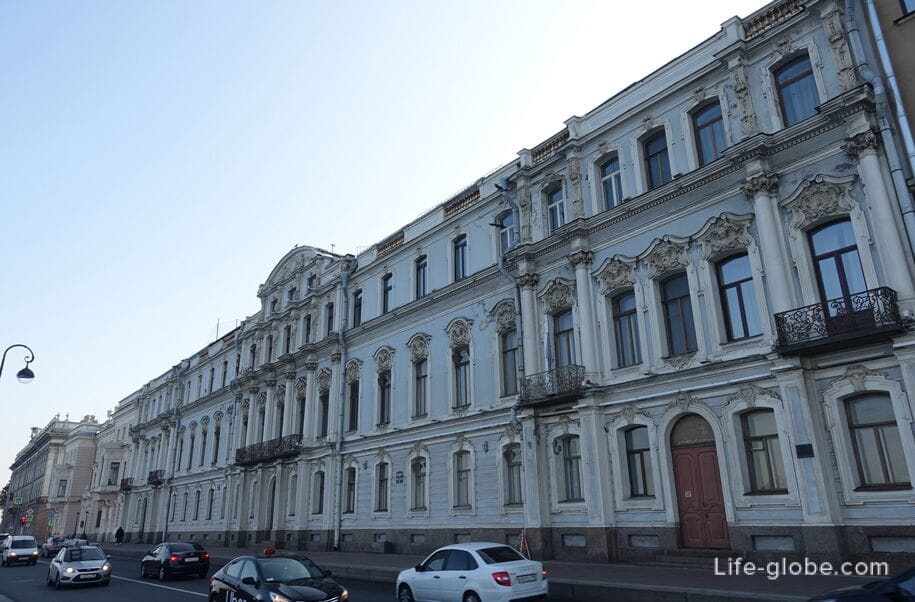

Houses # 12-16
The history of the houses numbered 12, 14 and 16 dates back to the 18th century, when they were still three separate houses.
During the history of the house was rebuilt and they changed their owners.
One of the owners of the houses numbered 12 and 14 was the New Club, formed in 1893 by young people from rich noble families. Entry into the club was only possible with the recommendation of at least two of its members. Games were played at the New Club, with the exception of gambling.
In the house at number 16 was the famous English Assembly, which was one of the most prestigious clubs in St. Petersburg. The entertainment at the English Club was talking and reading. The local cuisine was famous throughout the city. The number of seats in the club was strictly limited, so applicants for membership had to wait for their turn for several years and pay large fees.
After the October Revolution of 1917, the New and English clubs ceased to exist. Their premises were occupied by communal apartments.
In the 1950s, the front facades of the three houses on the Palace Embankment were combined and today they look like a single building in the style of the "Stalinist Empire".
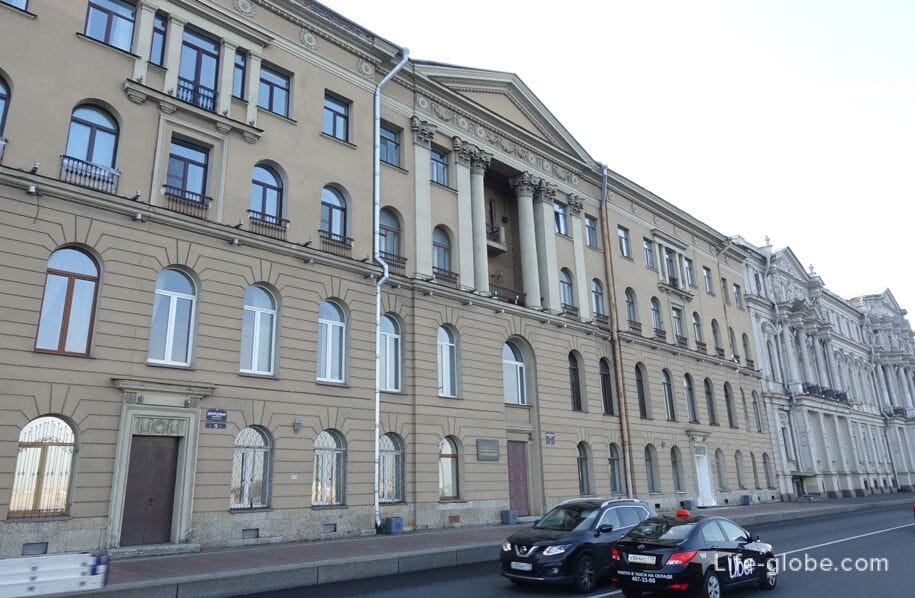

Novo-Mikhailovsky Palace
At the address: Dvortsovaya embankment 18, there is a magnificent grand ducal Novo-Mikhailovsky Palace.
The palace was built in 1857-1862 by the architect Andrey Ivanovich Stackenschneider as the residence of Grand Duke Mikhail Nikolaevich-the fourth son of Emperor Nicholas I.
The name "Novo -" palace was given because the city already had (and still has) one Mikhailovsky Palace.
After the October Revolution in 1917, the palace was nationalized, and the Communist Academy was located within its walls.
Today, the western wing of the Novo-Mikhailovsky Palace houses the Institute of Oriental Manuscripts of the Russian Academy of Sciences. Inside the palace, a number of historical interiors of the second half of the 19th and early 20th centuries have been preserved. You can visit the palace with a tour of the Institute of Oriental Manuscripts of the Russian Academy of Sciences.
The building of the former Novo-Mikhailovsky Palace has an early eclectic style (a mixture of different architectural styles and trends).
The facade facing the Palace Embankment (the main facade of the palace) is decorated with Carrara marble. The facade is decorated with stucco drawings and is distinguished by three risalites. The risalites of the palace are crowned with triangular pediments filled with figured decorations. Read more about the Novo-Mikhailovsky Palace…


Houses No. 20 and 22
The houses at numbers 20 and 22, separated by Moshkov Lane, are two two-story small historical houses that look similar and have balconies.
The plot of land on which the house was built (number 20) in the early 18th century, by decree of Peter I was given to Peter Moshkov. The mansion built there was sold by the first owner to the merchant Pyotr Terentyevich Rezvom, whose son resold the land to the adjutant General Count Christopher Andreevich Lieven. In 1810, when the Levins left for Berlin, Alexander Ivanovich Sologub bought the house from them.
The house at number 22 with a small attic, since 1877 belonged to Grigory Alexandrovich Chertkov. According to his order, two houses that were previously located on this site, by the architect R. A. Guedike, were combined into one in the "Louis XVI style", that is, early French classicism. After 1917, the house was nationalized.
House № 24
The house at number 24 has different names: Trofimov's mansion, Plautin's apartment house and Arkharov's house.
The architect of the original house is unknown, but many sources claim that already in the 1720s on the Palace Embankment 24 stood a two-story building, built according to a typical project at that time.
During the history of the mansion was rebuilt, and it changed several owners. So, in the mid-1770s, the building belonged to one of the most famous St. Petersburg detectives of that time - Nikolai Petrovich Arkharov, to whom the house was granted by Catherine II.
In 1843, the Polish Countess Evelina of Gania, Balzac's lover, lived in the house.
The house was also owned by Colonel V. I. Trofimov, for whom in 1859-1860 the architect G. M. Bartsch re-decorated the main facade of the building.
By 1900, the plot was owned by Lieutenant General Sergei Nikolaevich Plautin. For Plautin, civil engineer A. A. Smirnov built the building on the side of the Palace Embankment with three floors, re-tiled the main facade and redid many of the interiors. So the house became five-story.
The building survived the revolution and survived during the Great Patriotic War. The house still remains residential.
The facade of the house has a gray-blue color, there are stucco decorations, columns, balconies and the attic that completes the structure.

Palace of Vladimir Alexandrovich (House of Scientists)
At the address: Dvortsovaya Embankment 26, there is the so-called house of Scientists named after M. Gorky of the Russian Academy of Sciences or the palace of Vladimir Alexandrovich.
The House of Scientists is an association of employees of scientific institutions and higher education, the oldest creative club of scientific intelligentsia in the former USSR, opened on January 31, 1920 by the decision of the Petrograd Soviet on the initiative of the Petrograd Commission for Improving the Life of Scientists (Chairman Maxim Gorky).
The House of Scientists is located in the former palace of Grand Duke Vladimir Alexandrovich.
Today, the House of Scientists hosts concerts, exhibitions, conferences, meetings, events and sightseeing tours of the interiors of the building: visits to the personal apartments of the grand ducal family and ceremonial halls. Read more about the House of Scientists (the palace of Vladimir Alexandrovich) with a photo and a website...
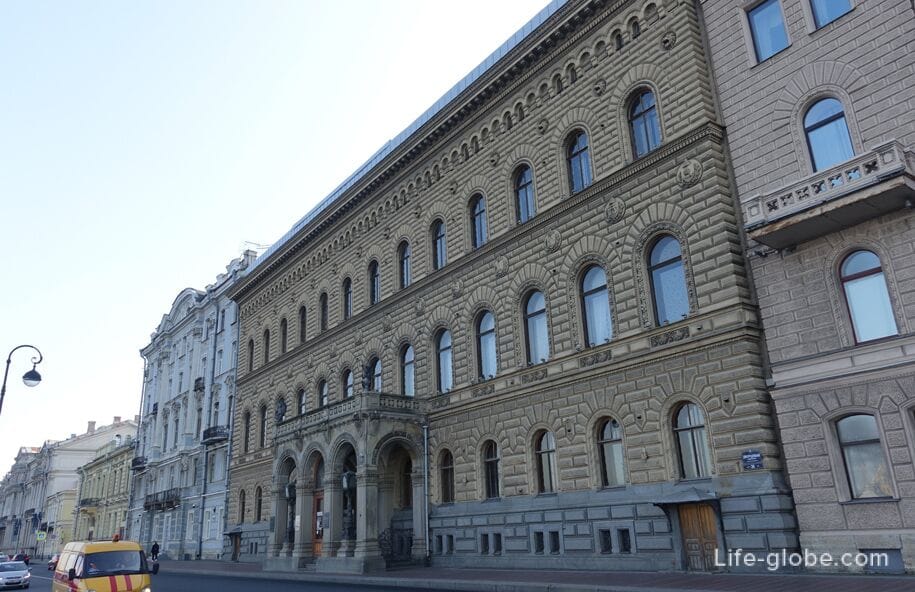
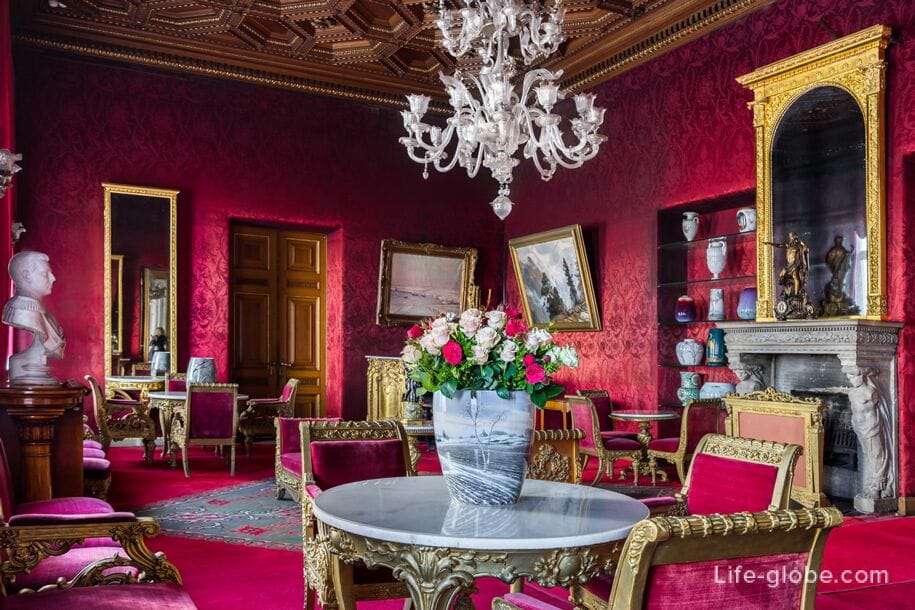
Vladimir Alexandrovich's spare house
At the address: Dvortsovaya Embankment 28, there is a spare house of the palace of Grand Duke Vladimir Alexandrovich.
Originally the house was two-storeyed wooden, but later it was built in stone according to the standard project.
Since 1836, a new courtyard wing of four floors was erected. The house became profitable, the premises in it were rented out.
After the construction of the neighboring palace of Grand Duke Vladimir Alexandrovich in 1862-1874, this building became his spare home.
After 1917, the palace of Vladimir Alexandrovich was transferred to the needs of the House of Scientists, and scientists were settled in this house.
Both buildings (Nos. 26 and 28) have similar features and facades with high porches.
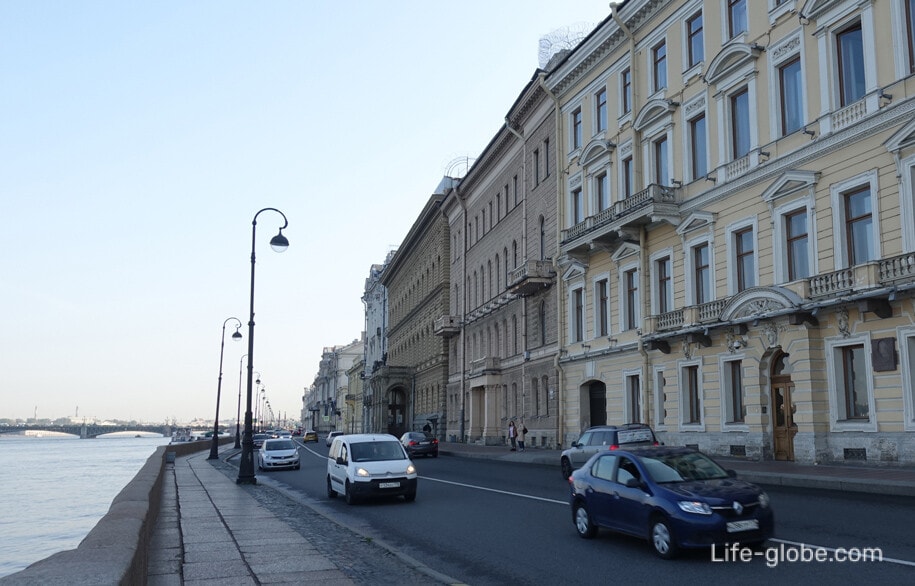
State Hermitage Museum
All the buildings along the Palace Embankment further, from house No. 30 to the Palace Bridge, belong to the State Hermitage Museum.
The buildings are connected by covered passageways and today they house the collections of the Hermitage and restored historical interiors. Read more about the State Hermitage Museum…
The spare house is a mansion, as well as a palace, which acquired its present appearance at the end of the 19th century, when it was built by the architect Nikolai Becker for Grand Duke Alexei Alexandrovich on the site of older buildings.
Subsequently, the house was used for various purposes. Many employees of the Hermitage lived directly at the museum.
Currently, the building houses the museum restoration workshops of the Hermitage.
Address of the house: Dvortsovaya Embankment, 30 / Millionnaya Street, 31.
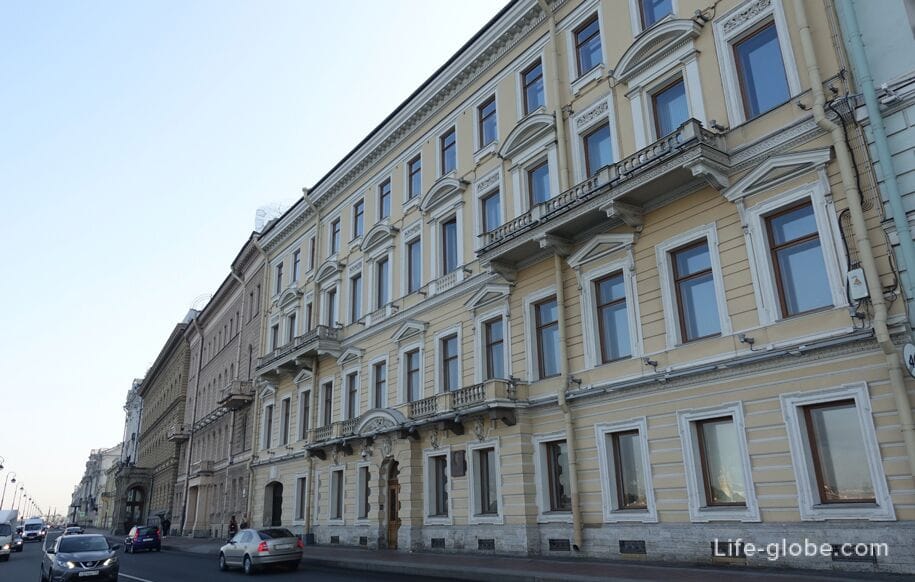
The Hermitage Theater and the Winter Palace of Peterthe Great, which today are a single building located along the Palace Embankment and the embankment of the Winter Canal.
The Winter Palace of Peter the Great was built in 1712 as the personal residence of Emperor Peter the Great.
At the end of the 18th century, the Hermitage Theater was built on the site of the palace, and only a small part (rooms) have survived from the former palace, which are now included in the Hermitage Theater.
The Hermitage Theater is one of the oldest in St. Petersburg and in Russia. Today it is one of the most popular stage venues in St. Petersburg. The theater gives performances and concerts, and exhibitions are held in its lobby.
In the preserved part of the Winter Palace of Peter the Great there is a memorial exhibition dedicated to Peter the Great and his era.
Address of the Hermitage Theater: 32 Dvortsovaya Embankment. Read more about the Hermitage Theater (the Winter Palace of Peter the Great)…
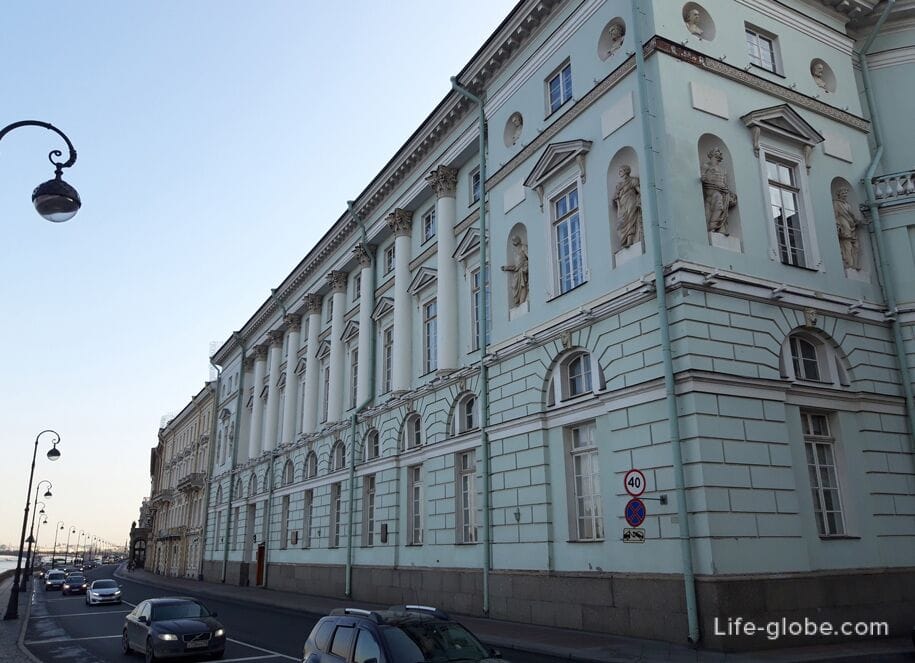
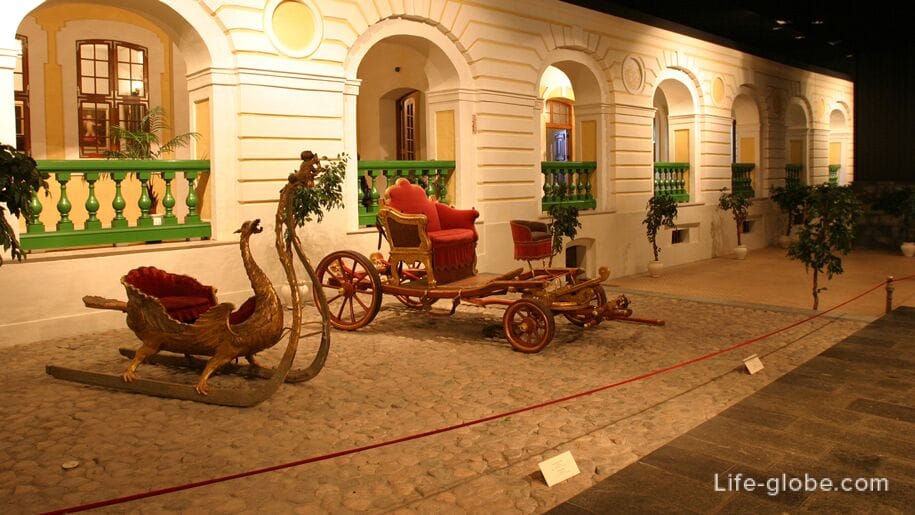
Behind the Hermitage Theater, through the Winter Groove, runs a single-span archedHermitage Bridge, which is one of the oldest stone bridges in St. Petersburg.
The first wooden drawbridge on this site was spanned in 1718-1720 by Harman van Boles.
Subsequently, the bridge was rebuilt.
The permanent stone bridge was built in 1763-1766, simultaneously with the construction of the granite embankments of the Neva River, becoming the first stone bridge in the city.
In 1934, the brick-and-tile arch of the bridge was replaced with a reinforced concrete (monolithic boltless) with outrigger heels and an internal outline, while the external appearance of the bridge was preserved.
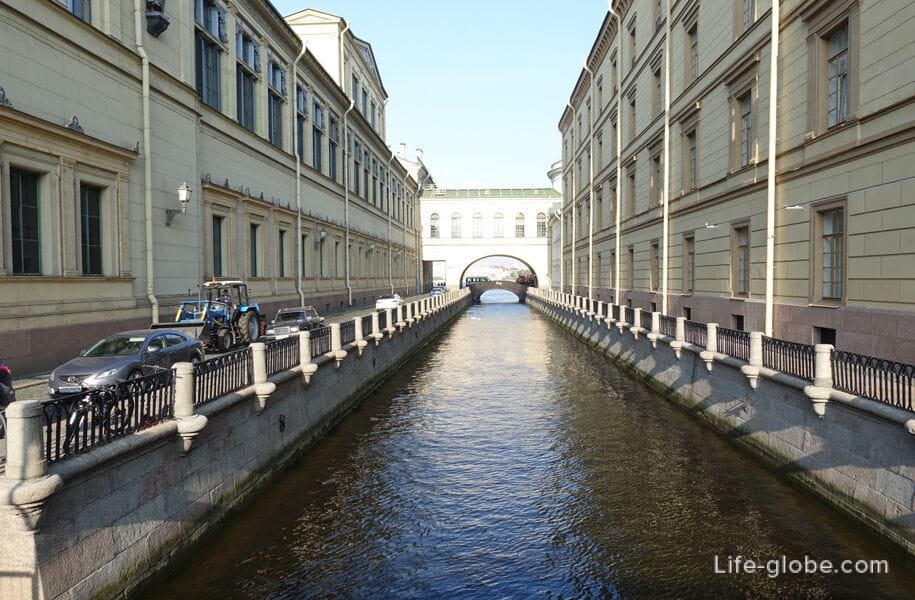
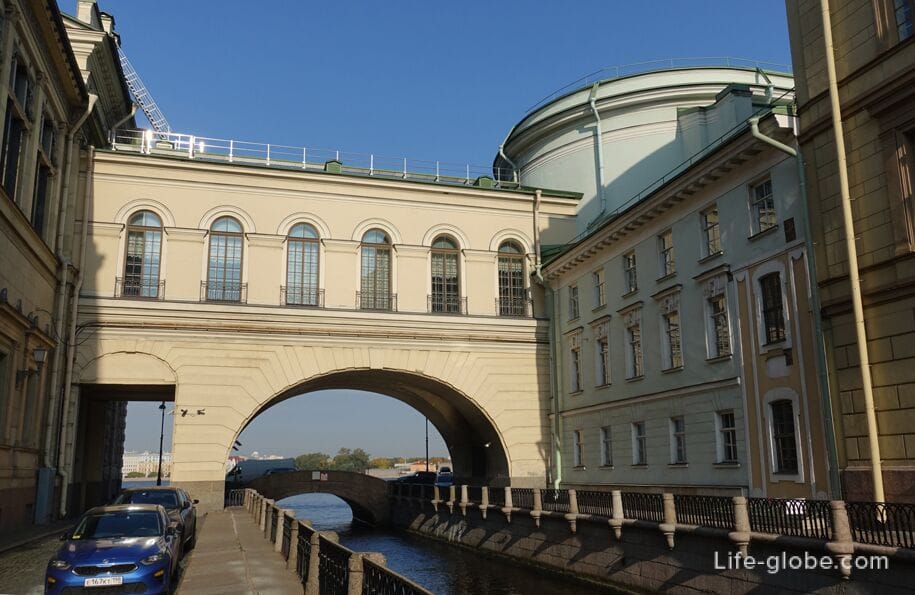
The Grand (old) Hermitage was built in 1771-1787 by the architect Yu. M. Felten, commissioned by the Empress Catherine II as a continuation of the palace buildings, to house the palace collections and library. Since the building was built on the banks of the Neva River next to the Small Hermitage, and surpassed the latter in size, it became known as the Great Hermitage.
In 1792, Giacomo Quarenghi added a building to the Grand Hermitage, which housed the Loggias of Raphael - a close-to-the-original repetition of the famous gallery of the Papal Palace in Rome.The Vatican.
Located in the Old Hermitage, the museum's exposition presents the art of Renaissance Italy.
Address of the old Hermitage: 34 Dvortsovaya Embankment.
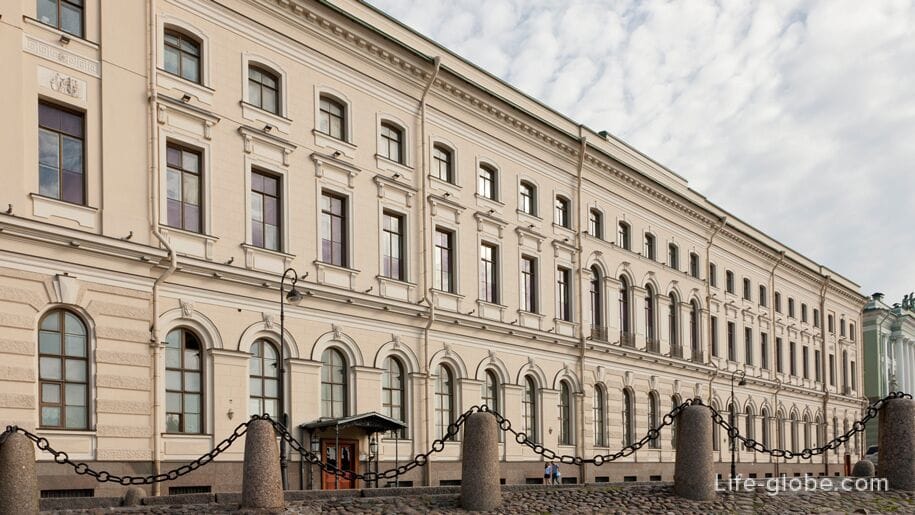
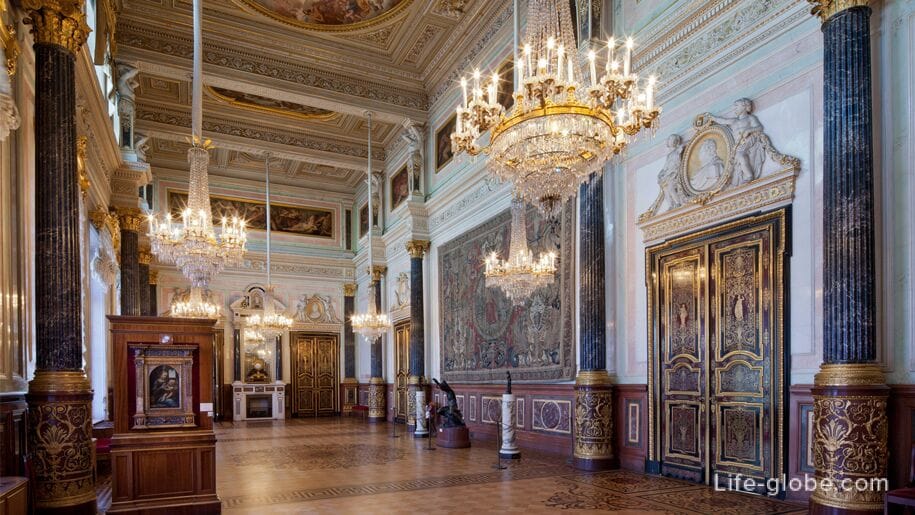
The Small Hermitage is an architectural monument that was built in 1764-1769 by the decree of the Empress Catherine II.
At the level of the second floor of the building there is an enclosed courtyard - former Hanging Gardens, which today contain flower beds, a fountain and several sculptures.
In the halls of the small Hermitage there are expositions of painting and applied art of Western Europe. And in the Pavilion Hall, created in the 1850s by A. I. Stackenschneider, the famous Peacock clock, made by an English mechanic in London in the 1770s, is stored.
The northern facade of the Small Hermitage overlooks the Palace Embankment, and the southern facade - on Millionnaya Street. Read more about the Small Hermitage…
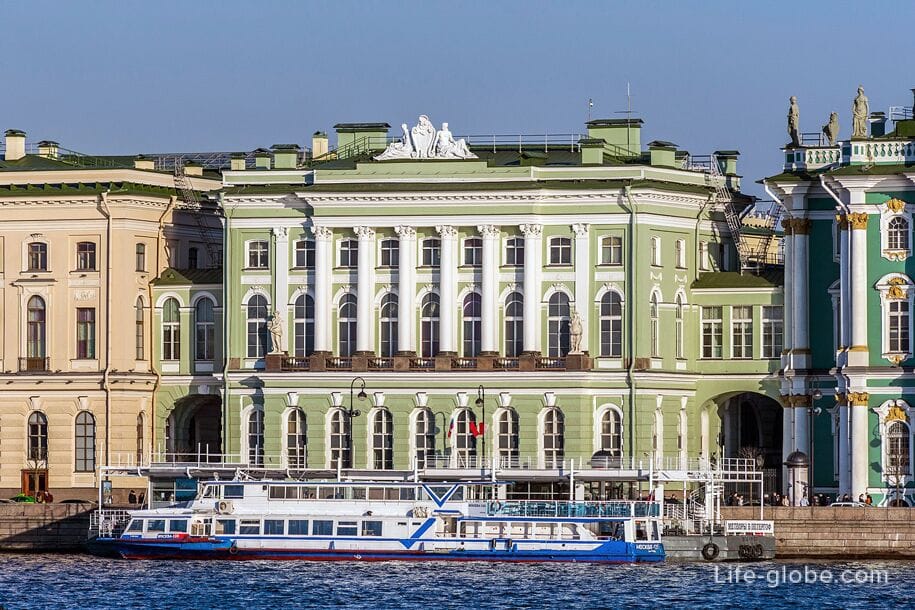
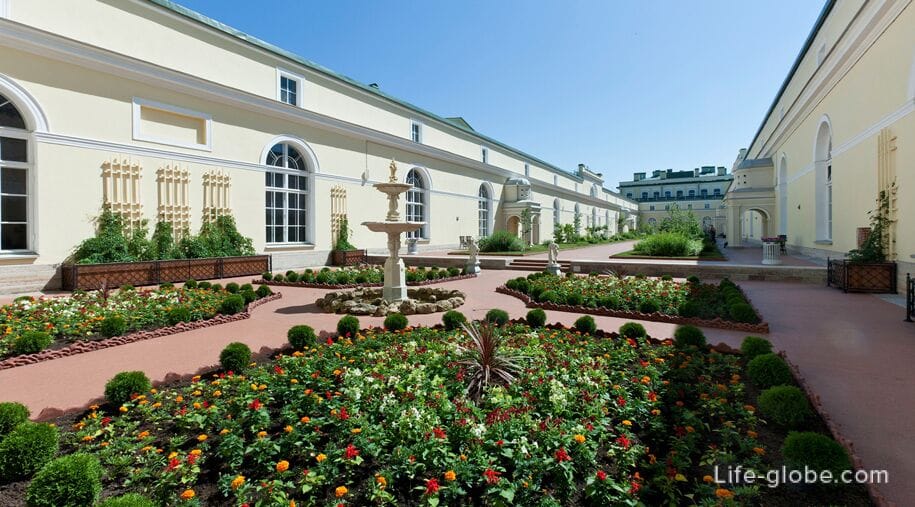
The Winter Palace is a former imperial residence and a striking monument of the Baroque style, with its main facade facing the Palace Square, and its northern facade facing the Palace Embankment.
The Winter Palace is the largest and one of the most famous palaces not only in Russia, but also in Europe.
The current building of the Winter Palace was built in 1754-1762, commissioned by the Empress Elizabeth Petrovna by the architect of Italian origin Francesco Bartolomeo Rastrelli.
The expositions of the State Hermitage Museum, located in the Winter Palace, represent recreated state halls and apartments of the royal family, contain collections of antiquities of Eurasia and the East, as well as a collection of paintings, sculptures and decorative arts of Europe and the East. Learn more about the Winter Palace…

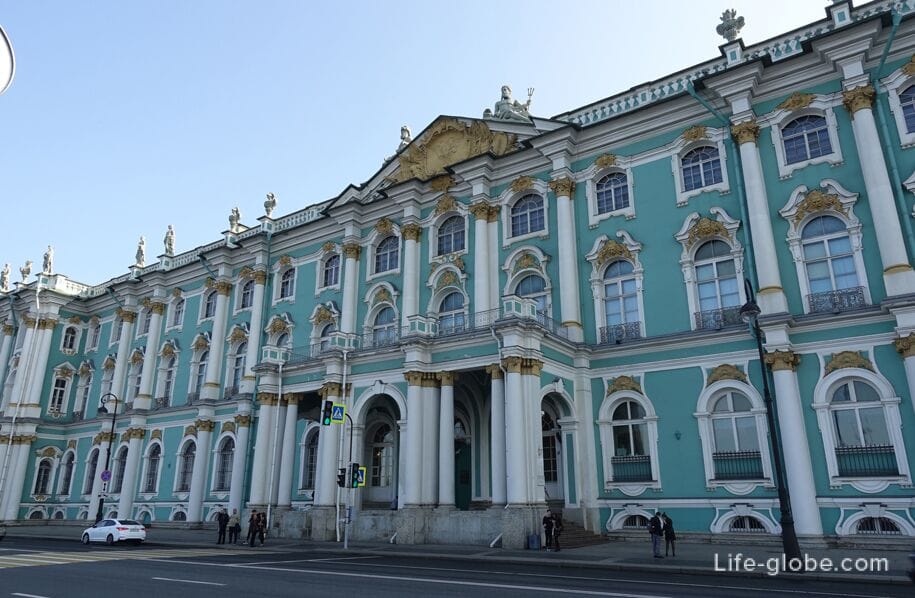
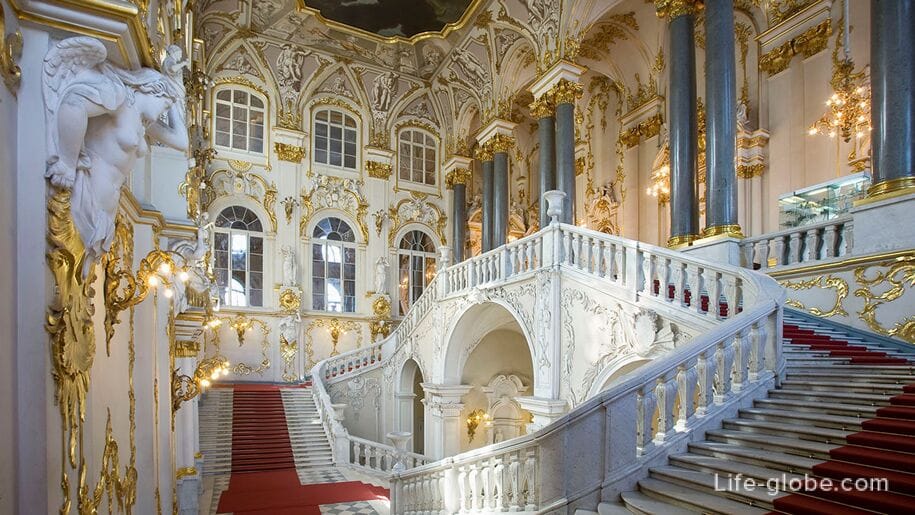
Winter Palace Garden and Palace Bridge
The Palace Embankment ends near an open public space that forms a small garden of the Winter Palace and where the Palace Bridge spans the Neva River.
The Winter Palace Garden is adjacent to the western facade of the Winter Palace and is a public square with walking paths, recreation areas, flower beds and a fountain. Learn more about the Winter Palace Garden…
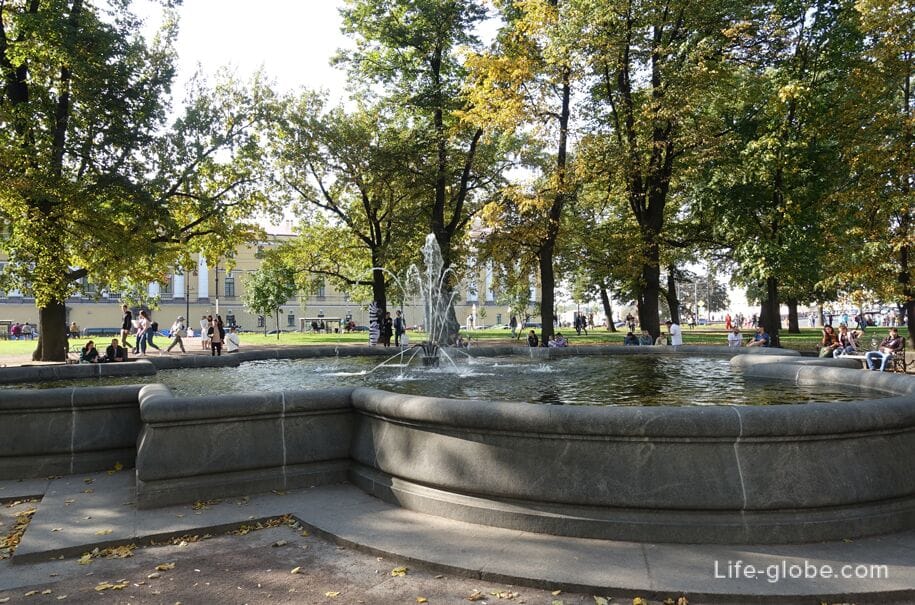
The Palace Bridge is one of the most majestic bridges in St. Petersburg, and from the point of view of engineering - it is one of the most complex structures not only in Russia, but also abroad.
The popularity of the bridge is also given by the fact that the Palace Bridge is a drawbridge.
The Palace Bridge connects the central part of St. Petersburg-Palace Square (Admiralteiskaya and Dvortsovaya embankments) with Vasilievsky Island.
The total length of the bridge is 267.5 meters, and its width is 31.6 meters.
The central part of the bridge-passing in both directions. On both sides of the bridge there are pedestrian sidewalks, fenced with railings. The bridge is illuminated by 28 lanterns mounted on 16 pillars. Learn more about the Palace Bridge…
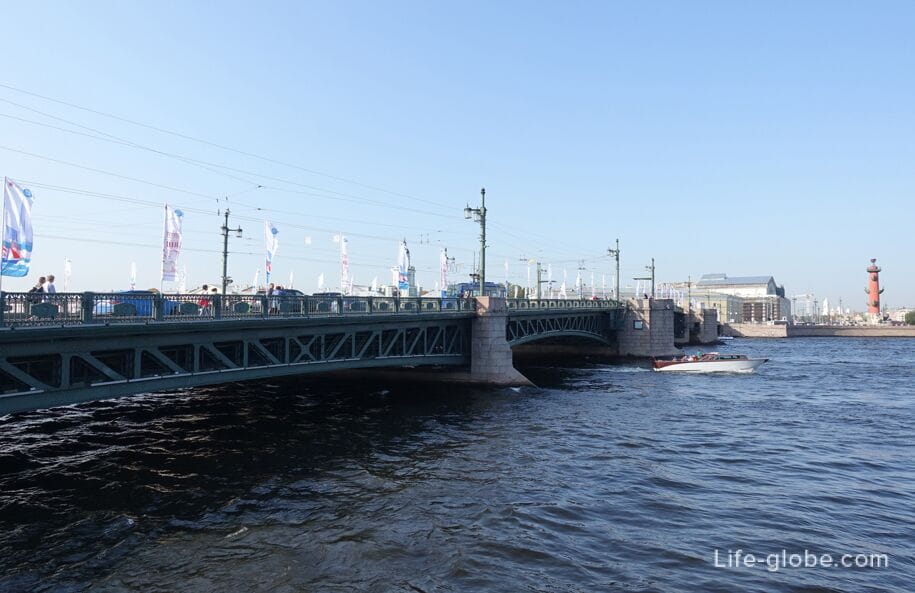

Practical information
On the Palace embankment there are berths of pleasure boats: "Summer Garden" (city pier) and "Palace Pier".
The Palace Embankment is located in the heart of St. Petersburg, close to Palace Square, St. Isaac's and Senate Square.
The nearest metrostations are "Admiralteiskaya", "Nevsky Prospekt", "Gostiny Dvor", "Gorkovskaya" and "Chernyshevskaya".
All accommodation facilities in St. Petersburg, including in the city center and near the Palace Embankment, can be viewed and booked here






